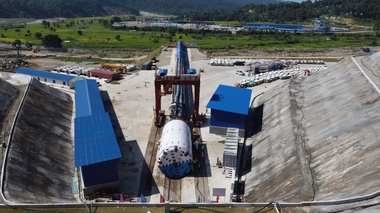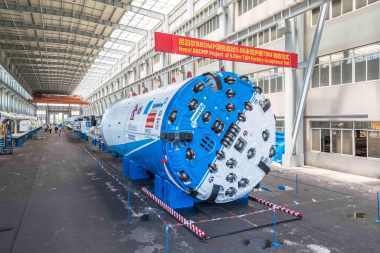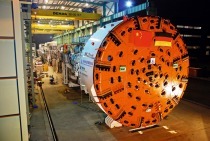Challenging Drive at China’s Yin Han Ji Wei Water Diversion Project Completed
An 8 m diameter Main Beam TBM broke through at China’s Yin Han Ji Wei project in the first quarter of 2022. The project is considered to be one of the most challenging ever completed by a TBM, with crews encountering abrasive hard rock, over 14 000 rock bursts, and multiple severe water inflow events. The machine overcame 17.5 km of tunnel in some of the most difficult geology ever encountered. The water diversion tunnel traverses the Qinling Mountains of Shaanxi Province, with up to 2000 m of cover.
 An 8 m diameter Main Beam TBM broke through at China’s Yin Han Ji Wei project in the first quarter of 2022. The project is considered to be one of the most challenging ever completed by a TBM
An 8 m diameter Main Beam TBM broke through at China’s Yin Han Ji Wei project in the first quarter of 2022. The project is considered to be one of the most challenging ever completed by a TBM
Credit/Quelle: Robbins
The ground, consisting of mainly quartzite and granite, was estimated to have a rock hardness of between 107 and 309 MPa UCS, with high abrasivity and a maximum quartz content of 92.6%. During tunneling, the crews of the China Railway Tunnel Group (CRTG) encountered over 14 000 rock bursts, some with energy as high as 4080 kJ. Water ingress occurred a total of 69 times during the drive, with some inflows extremely high – exceeding 20 000 m3 of water in one day from a single point. In-tunnel ambient temperatures peaked at 40 degrees Celsius and 90% humidity.
 During tunneling, crews encountered over 14 000 rock bursts, some with energy as high as 4080 kJ
During tunneling, crews encountered over 14 000 rock bursts, some with energy as high as 4080 kJ
Credit/Quelle: Robbins
Throughout the challenges, the crew found ways to persevere. Rock bursting was controlled using steel slats in conjunction with the McNally crown support system, while zones of stress were predicted using a micro-seismic monitoring system. The micro-seismic system records rock stresses in a borehole 20 m ahead of the face and predicts the potential for rock bursting following comparative analysis with similar rockburst data from other projects, as well as from nearby sections of tunnel in the Qinling Mountains.
Water ingress was controlled by dramatically increasing pumping capacity in the tunnel to 41 000 m3 per day. Systematic probing ahead of the TBM was also used to detect water, as well as rock bursting. When ingress exceeded 70 percent of the in-tunnel pumping capacity, crews then carried out grout injections.
With TBM tunneling complete, the route will become part of two other sections of an altogether 82 km long tunnel that will link up the Hanjiang and Weihe Rivers in Shaanxi province. The completed tunnel, for owner Hanjiang-to-Weihe River Valley Water Diversion Project Construction Company, will secure a water supply for towns and agricultural areas in Central China, while also generating hydroelectricity.






